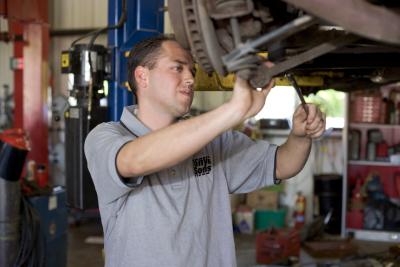
Dragging brake pads on a Chevrolet Silverado will cause the pads and rotors to prematurely wear. When replacing brake pads, there are a few things you should do to ensure the pads and rotors have the longest life as possible. Rather than rush through a simple brake job, take the time to service the brakes properly to maximize braking efficiency and brake life.
Lift the Chevrolet Silverado with the jack and place it on jack stands.
Remove the wheels with a lug-nut wrench and set them aside.
Remove the caliper with a ratchet and use a bungee cord to hang the caliper. Do not let the caliper hang from the brake hose as it might break and cause fluid to leak.
Pull the brake pads out of the brake caliper bracket. If they don't come out easy, you can use a flathead screwdriver to pry between the brake pad and the rotor.
Sand the brake pad holder with 500-grit sandpaper until you see bare metal. If any corrosion remains on the holder, the brake pad will stick.
Sand the edges of the brake pad where it makes contact with the brake pad holder. Sand until it is smooth.
Place the brake pads back into the brake caliper bracket.
Remove the pins from the caliper and clean them of any grease. Place new brake anti-seize onto the pins and put them back into the caliper.
Open the master cylinder reservoir so you don't break a seal while compressing the brake caliper.
Compress the brake caliper with a C-clamp so the caliper can fit over the new brake pads. Install the caliper by securing it to the brake caliper bracket with a ratchet.